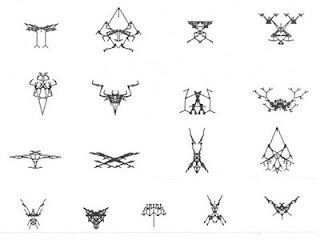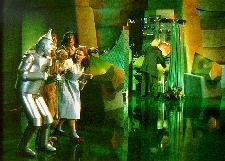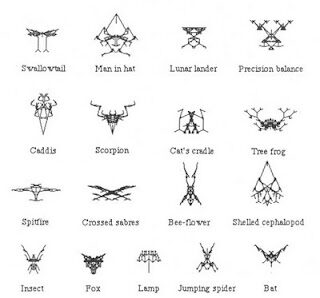This essay consists of the Professor Richard Dawkins portions of a more encompassing essay entitled Look Both Ways Two Atheistic Logical Fallacies. The point of the original essay is that it is very common to find atheists committing twin logical fallacies that we have termed: the fallacy of validation by projection and the fallacy of validation by regression. In order to validate their beliefs atheist look both ways, up and down, the corridors of time-to the inaccessible past and future. They can imagine a time, long, long ago in the Earth’s past, when everything happened just so and abiogenesis was possible. Likewise, they can imagine a time in the distant future when their beliefs will be proven true.
In our essay The Gap Filler we deal, in some detail, with the following statement from an interview of Prof. Richard Dawkins by Jonathan Miller.1
“Um, there’s got to be a series of advantages all the way in the feather. If you can’t think of one then that’s your problem, not natural selection’s problem. Natural selection, um, well, I suppose that is a sort of matter of faith on my, on my part since the theory is so coherent and so powerful. You might mentioned feathers. I mean it’s perfectly possible that feathers began as fluffy, um, extensions of reptilian scales to act as heat insulators. And so the final perfection of the sort of, wing feathers that we see in flying birds might have come very much later. And the earliest feathers might have been a different approach to hairiness among reptiles keeping them warm.”
Prof. Richard Dawkins fills the gaps in his knowledge with his faith. Since there is no evidence, we can appeal to our imagination (in the guise of respectable science). It is “perfectly possible” it “might have” and again, it “might have”-and that is proof enough.
Prof. Richard Dawkins wrote:
“Human thoughts and emotions emerge from exceedingly complex interconnections of physical entities within the brain. An atheist in this sense of philosophical naturalist is somebody who believes there is nothing beyond the natural, physical world, no supernatural creative intelligence lurking behind the observable universe, no soul that outlasts the body and no miracles – except in the sense of natural phenomena that we don’t yet understand. If there is something that appears to lie beyond the natural world as it is now imperfectly understood, we hope eventually to understand it and embrace it within the natural.”2
Note the presupposition: we know that absolute materialism is true and so the supernatural is disqualified a priori. If we ever encounter a miracle, if we are exposed to evidence of a miracle, we are do disregard it as being the outworking of some materialistic phenomena that “we don’t yet understand.” But we can project and so “we hope” to “eventually” be able to explain all things according to the worldview of materialism.
Prof. Richard Dawkins wrote:
“Chance, luck, coincidence, miracle_events that we commonly call miracles are not supernatural, but are part of a spectrum of more-or-less improbable natural events. A miracle, in other words, if it occurs at all, is a tremendous stoke of luck.”3
But what of his own view of origins?:
“It is as though, in our theory of how we came to exist, we are allowed to postulate a certain ration of luck.”4
He also wrote:
“If I saw a man levitating himself, before rejecting the whole of physics I would suspect that I was the victim of a hallucination or a conjuring trick.”5
Certainly, it could be a trick and one aught to investigate but it is fascinating that his reaction to being an eyewitness to something that violates his worldview, that violates absolute materialism, would be to prefer the explanation of it being a hallucination (see our essay: What Would Atheists Do If God Appeared To Them?).
Prof. Richard Dawkins wrote:
“My guess is that both bats and birds evolved flight by gliding downwards from the trees. Their ancestors might have looked a little like colugos. Birds could be another matter…. Here’s one guess as to how flying got started in birds_.Perhaps birds began by leaping off the ground while bats began gliding out of trees. Or perhaps birds too began by gliding out of trees_The beauty of this theory is that the same nervous circuits that were used to control the centre of gravity in the jumping ancestor would, rather effortlessly, have lent themselves to controlling the flight surfaces later in the evolutionary story.”6
More of the same, “_guess_might have_could be_guess_Perhaps_perhaps_The beauty of this theory is_the evolutionary story.”
Prof. Richard Dawkins begins the third chapter of River Out of Eden – A Darwinian View of Life by referencing a letter that he received from a former atheist who is now a Minister. The Minister became a believer in God while reading an article regarding a particular Orchid whose flowers mimic a wasp. It does not merely mimic a wasp, but a particular kind of wasp. Not merely a particular kind but the female of that particular kind. Yet, this is not simple the case of someone who “found faith through a wasp,”7 as Prof. Richard Dawkins puts it. The Minister was captivate by thought that “No incremental steps could account for it…”8 This is because the mimicry includes at least three aspects: morphology, chemistry and anatomy. The Minister’s reasoning went on to state “_if the orchid did not look like and smell like the female wasp, and have an opening suitable for copulation with the pollen within perfect reach of the male wasp’s reproductive organ, the strategy would have been a complete failure.” Prof. Richard Dawkins then proceeds to explain his indignation for the sort of argument that would state “that complicated contrivances have to be perfect if they are to work at all.”9 Prof. Richard Dawkins’ tactic is to claim that the Orchid does not actually have to look very much like a wasp (he does not actually assert that it does not, he merely claims that it does not have to).
Prof. Richard Dawkins writes:
“Perhaps a fleeting view of a female is all a fast-flying wasp can expect to get before attempting to copulate with her. Perhaps male wasps notice only a few key stimuli anyway. There is every reason to think that wasps might be even easier to fool than humans.”
Note the qualifying terms “Perhaps_Perhaps.”
He then expends six pages offering examples of apparently poor eyesight in certain birds and insects and points out:
“The world as seen through an insect’s eyes is so alien to us that to make statements based on our own experience when discussing how ‘perfectly’ an orchid needs to mimic a female wasp’s body is human presumption.”
Interesting point, although there seems to be a bit of logical conclusion missing here: he seems to be overlooking the fact that the reason we know that an Orchid produces a flower that mimics a wasp is that it is us human beings who observe that the flower looks like a wasp (not merely in basic shape but anatomically). Why would an Orchid produce a flower that looks, to a human being, like a wasp but not so much to a wasp?
Yet, Prof. Richard Dawkins then does a 180 degree turn in stating:
“I may have done my work too well in persuading you that wasps are likely to be easy to fool_If insect eyesight is so poor, and if wasps are so easy to fool, why does the orchid bother to make its flower as wasp-like as it is? Well, wasp eyesight is not always so poor. There are situations in which wasps seem to see quite well.”10
He then provides two pages worth of examples and then concludes be regressing to his earlier point:
“a crude resemblance between orchid and female might well be sufficient. The general lesson we should learn is never to use human judgment in assessing such matters.”11
Please note that in his six pages of poor, and two of good, eyesight he never once discussed the Orchid, its flower, the wasp, or the mating/pollination. He merely made assertions based on long-shot circuitous assertions.He most certainly did not touch upon another aspect of the issue:Somehow, a plant knows what a particular kind of wasp looks like.It knows the wasp’s matting habits.It knows that it needs to attract males.It somehow wills itself to produce a flower that looks like the female so that the male will land on the flower and assist in pollination.It produces pheromones that attract the particular kind of male wasp.It mimics the female wasps’ anatomy.It places its pollen in the right place.
Nevertheless, Prof. Richard Dawkins states:
“Never say, and never take seriously anybody who says, ‘I cannot believe that so-and-so could have evolved by gradual selection.’”12
He does not offer one single example of how the process actually took place.Just how does a plant have such a detailed understanding of the world that exists around it-the creatures, their anatomy, their mating habits, etc.? How does a plant conceive of, and carry out, a plan to produce a mimic of such a creature?
Not to worry, knowing something about the atheistic/materialistic cooption of science, all that is necessary is to concoct a story about how it could have happened and that is good enough. In the same chapter we have been discussing, Prof. Richard Dawkins tackles how the honeybee’s dance evolved. The dance in question is performed by a bee that has found food. Upon returning to the nest it performs a dance that is, in fact, a coded message that informs other bees in which direction and to what distance they are to travel in order to retrieve the food. We will provide the qualifying terms that are peppered throughout his story:
“plausible_suggests_would have_Perhaps_plausible_plausibility_plausible_might have_would have_It is not difficult to imagine_probably_plausible_ plausible_ plausible.”13
He finally states:
“The story as I have told it_may not actually be the right one. But something a bit like it surely did happen.”14
Before continuing, please take a moment to contemplate the following illustrations.
 Chapter 3 of Prof. Richard Dawkins’ book The Blind Watchmaker-Why the Evidence of Evolution Reveals a Universe Without Design is entitled Accumulating Small Changes. In this chapter he, unwittingly, proves that a creator, an intelligent designer, is required to even merely conceive of biological entities reproducing/evolving.He begins by stating:
Chapter 3 of Prof. Richard Dawkins’ book The Blind Watchmaker-Why the Evidence of Evolution Reveals a Universe Without Design is entitled Accumulating Small Changes. In this chapter he, unwittingly, proves that a creator, an intelligent designer, is required to even merely conceive of biological entities reproducing/evolving.He begins by stating:
“We have seens that living things are too improbable and too beautifully ‘designed’ to have come into existance by chance. How, then, did they come into existance? The answer, Darwin’s answer, is by gradual, step-by-step transformation from simple beginnings, from primordial entities sufficiently simple to have come into existence by chance.”15
Prof. Richard Dawkins’ view is that life began by pure chance and then evolved but not by chance because natural selection selects in a nonrandom manner, even though it has no foresight, no goal to which it is aiming its selections.
Prof. Richard Dawkins set out to create a world with which to test his theory of evolution. His intelligent design came in the form of a computer program that, instead of letters, would “draw pictures instead” to the end that, “Maybe we shall even see animal-like shapes evolving in the computer, by cumulative selection of mutant forms.”16 Keep in mind this prediction of seeing animal-like shapes. Prof. Richard Dawkins begins his experiment by relying on a tremendous amount of intelligence, not just his own personal education but by relying on a computer-a machine that was specifically designed by intelligent beings. Consider the millennia that was required for humanity to compile enough knowledge to build a computer, from the manipulation of the substances that make up its hardware to the foresight that makes up its software. Prof. Richard Dawkins comes to the task with “20 years’ experience of programming computers”17 under his belt.
Let us quickly survey the experiment, the intelligently designed world that Prof. Richard Dawkins calls Biomorph Land.
“_we must have_I chose one and wrote a program_what drawing rule shall we choose_are allowed to grow_when you tell the computer_rule for drawing_we wrap it up in a little computer procedure_first step towards writing this larger program_we shall modestly limit our computer model_How shall we make these genes influence development_I made_a constraint that I imposed on the DEVELOPMENT procedure. I did it partly for aesthetic reasons, partly to economize_I was hoping to evolve animal-like shapes_my mutations are all constrained_These are arbitrary conventions_two procedures called DEVELOPMENT and REPRODUCTION are written as two watertight compartments_We have assembled our two programs_bring the two modules together in the big program called EVOLUTION_This very high mutation rate is a distinctly unbiological feature of the computer model_The human eye has an active role to play in the story. It is the selecting agent_The human tells the computer which one of the current litter of progeny to breed from_I began to breed, generation after generation, form whichever child looked most like an insect_the monsters that one encounters are undersigned and unpredictable_”18
Apparently, at some point Prof. Richard Dawkins became aware of his creative actions as an intelligent designer. These include unbiological input and purposeful selection of shapes that he thought looked like what he wanted to see due to his foresight-planning and executing of a strategy in order to reach a desired goal. Thus, he attempts to deny doing what he has been admitting all along:
“I programmed EVOLUTION into the computer, but I did not plan ‘my’ insects_Yes I am piling on the drama a bit, but there is a serious point being made. The point of the story is that even though it was I that programmed the computer, telling it in great detail what to do, nevertheless I didn’t plan the animals that evolved.”19
Even so, he concludes:
“Does the powerlessness of the programmer to control or predict the course of evolution in the computer seem paradoxical? Does it mean that something mysterious, even mystical was going on inside the computer? Of course not. Nor is there anything mystical going on in the evolution of real animals and plants.”20
Pay no attention to that man behind the curtain: Prof. Richard Dawkins is indeed the creator god of his biomorphs, “my” he calls them, he created a world, its laws/rules, and its life. His chosen ones were selected for further evolution, a process that the creator manipulated towards his ends since he knows the beginning and the end. He even admits that the biomorphs were predestined, “There is a definite set of biomorphs, each permanently sitting in its own unique place in a mathematical space.”21

But what is it exactly that Prof. Richard Dawkins created? Animals? Insects? No. He created Rorschachs. He created several intersecting lines that then became more intersecting lines. Then he, the selector, the intelligent agent, interpreted what these lines look like to him. Recall that he stated, “I was hoping to evolve animal-like shapes” and that “The human eye_is the selecting agent.” Thus, he created and manipulated a world that produced Rorschachs-perhaps a psychiatrist would have more to say about the outcome than a biologist. But Prof. Richard Dawkins did not merely “see” insects and animals in his biomorphic Rorschachs, he also saw a Lunar Lander, a man in a hat, an upside-down menorah, a precision balance, crossed sabers, a lamp, etc. He does not bother explaining how a biological entity evolves into a saber or the Lunar Lander-he miraculously intervened upon biomorph land.

Example of Prof. Richard Dawkins’ creations with his subjective descriptions: fig 5 p. 61
Prof. Richard Dawkins concludes the chapter by writing:
“_when we are prevented form making a journey in reality, the imagination is not a bad substitute. For those, like me, who are not mathematicians, the computer can be a powerful friend to the imagination. Like mathematics, it doesn’t only stretch the imagination. It also disciplines and controls it.”22
This has been our point all along-escape reality and invent advantageous fictions: when the real world will not accommodate our world-view we can invent one that will. Why can we know that there is nothing mystical going on? Because nothing mystical is going on in our imaginary world.
Ultimately, the only thing that Prof. Richard Dawkins has accomplished engaging in tautology: he proposed a theory and then concocted an experiment that allowed him to manipulate the process from beginning to end so that in the end his theory was proven true.
